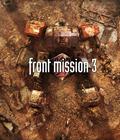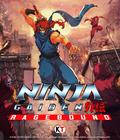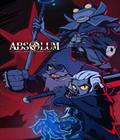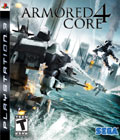Genre: Action
Publisher: Sega
Developer: From Software
Release Date: March 20, 2007
The Armored Core series dates back to the PlayStation 1, so chances are that you've heard of, or at least seen, an Armored Core game before. The newest installment of the series, Armored Core 4, streamlines the formula and cuts out a lot of unnecessary options in an attempt to make it friendlier for the mainstream audience. Some of the die-hards might complain about the simplified system, but it makes for a more fluid and fast-paced gameplay experience overall.
For those people who actually care about the story, AC4 occurs in the distant future, when earth has undergone a rapid population growth which has strained the food and energy supplies, caused massive civil unrest, and spurred terrorism and anarchy. Governments have collapsed, and in the midst of the chaos, mega corporations have taken over and now enforce law through the use of mercenaries.
Although this seems like an interesting story, the game presents it in very abrupt sequences, making it difficult to follow at times. After finishing the single-player campaign, I still didn't fully understand what had transpired or exactly what role my character played in it all. This might frustrate some people, but for everyone else who just wants to blow up stuff in a giant robot, it suffices. As you complete the single-player missions, you will unlock data packs which allow you to enter a 1v1 arena fight against other Next pilots; this is essentially a replacement for the arena mode that was in many of the previous iterations.
In fact, a number of changes have been made to AC4: Inside and Exceed Orbit parts have been removed, heat is no longer a factor, and the redline on the energy meter has been taken out. The traditional targeting box that has been in series since the beginning has also been changed; you can now lock onto any on-screen enemy, instead of just the ones inside your targeting reticle. The various computer components affect the lock-on distance, lock-on speed, and amount of simultaneous targets.
The overall speed of the game has also been amped up, which allows for some pretty fast and intense action. Many of the die-hard AC fans might complain about these changes, as it simplifies the system, but I think most of the changes trimmed unnecessary features and made the series more approachable by a mainstream audience.
The true Armored Core fans can still fully customize their Nexts and make fine-tuned adjustments with FRS (fractional regulation system), which allows you to tweak specific machine properties, such as boost speed, accuracy, and carry capacity. On the other hand, the more casual gamers can use stock designs which come pre-built and have numerical representations for their abilities.
One of the new concepts added into Armored Core 4 is the Primal Armor, or PA, for short, which acts as a damage-resistant shield to protect your Next. It will stop a certain amount of damage from a hit, and the rest will be applied to your armor. Depending on the strength of your PA, you can be completely immune to some of the weaker attacks. Although each hit you take drains a bit of the PA energy, it will recharge over time.
Another new gameplay feature that was introduced was the quick boost, which is exactly what you get from your thrusters to dodge forward/backward or to the side. It uses up a good bit of energy but is useful for evading attacks. Unlike previous iterations, using the normal boost to move horizontally does not drain energy from your meter — only vertical movement, quick boosting, and over-boosting do that. This allows you to stay mobile the entire time, which is something you will need to do, as some missions will send an enormous amount of firepower at you.
However, the single-player mode has a few serious shortcomings. For starters, the single-player campaign is very short, with 37 missions spanning six chapters. This might have been enough if the missions were well-created, but they aren't. The faster gameplay is a good adjustment, but it should have been offset with more elaborate missions with multiple objectives. Most of the missions have a par time of three minutes or less, and I managed to beat several of the missions in under a minute. With such short missions, it is certainly easy to feel rushed, and you have no time to explore the levels or try different methods of play; longer, more in-depth missions would have greatly enhanced the experience. Additionally, as powerful as the 360 and PS3 may be, the levels are rather small; you don't have to fly very high before you hit the height limit and receive a warning that you are leaving the mission area. I think this was probably just a design oversight rather than a technical limitation, but it severely limits your movement in some of the missions.
For eight consecutive games on the PS2 from Armored Core 2 all the way to the not-so-memorable Armored Core: Last Raven, the series had been using the same graphical engine. In the beginning, it looked pretty good, but after almost seven years, it's not so amazing anymore. The newest generation on PS3 and Xbox 360 has a completely new graphical engine with some very nice and immersive visuals, and although the environments look good from a technical perspective, they appear somewhat bland. Most of the levels are rather small and have only a few buildings or objects to serve as scenery. The explosions look superb, though, and much of the lighting is well done and creates a believable post-apocalyptic atmosphere. The particle effects are also noteworthy, with very vivid smoke trails and booster exhaust effects. The Nexts are highly detailed, and you can customize them with your own emblems and paint schemes. The editors are a bit difficult to use, but for those who wish to spend the time, you can create some pretty unique designs.
The online play is major addition from previous versions. Now you can take your custom-designed mech and battle people online, and your stats will be recorded on leaderboards. This is a long-awaited feature for series vets, and it adds quite a bit of replay value for the hardcore enthusiasts who want to prove their robot-piloting skills. There are a few different game types to select from, such as 1v1, team matches up to 4v4, and four- or eight-man battle royals. You have the ability to trade schematics with other players online so you can show off your designs, but unfortunately, there is no easy way to view the schematics that other people are using. You must choose to change your Next to their design to view it, and then you have to go set up your Next again if you want to go back to what you had.
The sound is another plus for AC4, featuring some fairly good voiceover artists for the narration and pilots. The sound effects come across pretty crisp and clear as well, and it really adds to the immersion if experienced with fully Dolby surround sound. This is all accompanied by a great music soundtrack which deviates a bit from the more techno-heavy songs of the previous titles.
In the end, Armored Core 4 delivers more of what the series is known for: fast-paced, arcade-style mech action with highly customizable robots in which to fight. It does this with some very nice visuals to boot, although it fails to be really great with the extremely short campaign, forgettable missions/story, and a clunky user interface for the garage and shop. It isn't revolutionary by any means, but it's definitely a step in the right direction for the series.
Score: 7.5/10
More articles about Armored Core 4











 Armored Core 4 will allow players can create their own original mech by switching components such as the head, arms, and legs of the mech's body, with a few hundred components to choose from, including changing its color to give it an exclusive looks. By accepting and usccessfully completing missions, the player can purchase even more powerful parts to make his mech stronger.
Armored Core 4 will allow players can create their own original mech by switching components such as the head, arms, and legs of the mech's body, with a few hundred components to choose from, including changing its color to give it an exclusive looks. By accepting and usccessfully completing missions, the player can purchase even more powerful parts to make his mech stronger.

































